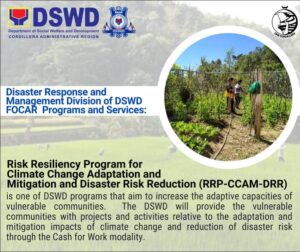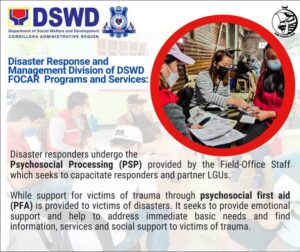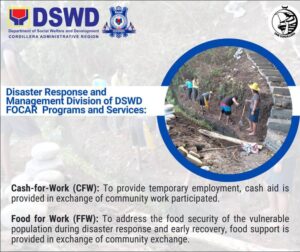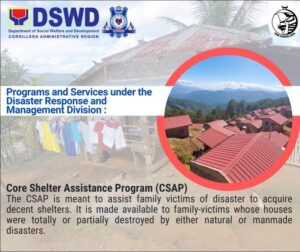The Department of Social Welfare and Development or DSWD is the Philippines’ lead agency responsible for providing social protection and promoting human development. In times of calamities and disasters, the DSWD mobilizes its resources to provide relief assistance and rehabilitation support to affected communities.
The department has helped families affected by calamities such as floods, typhoons, earthquakes, and volcanic eruptions as well as other crisis situations.
DSWD’s programs are based on the core values of compassion, empowerment, justice, love for the country, respect for human dignity, and stewardship of resources. These values guide the department in its efforts to provide assistance to those who are most vulnerable and at risk during times of calamities and disasters.
Contents
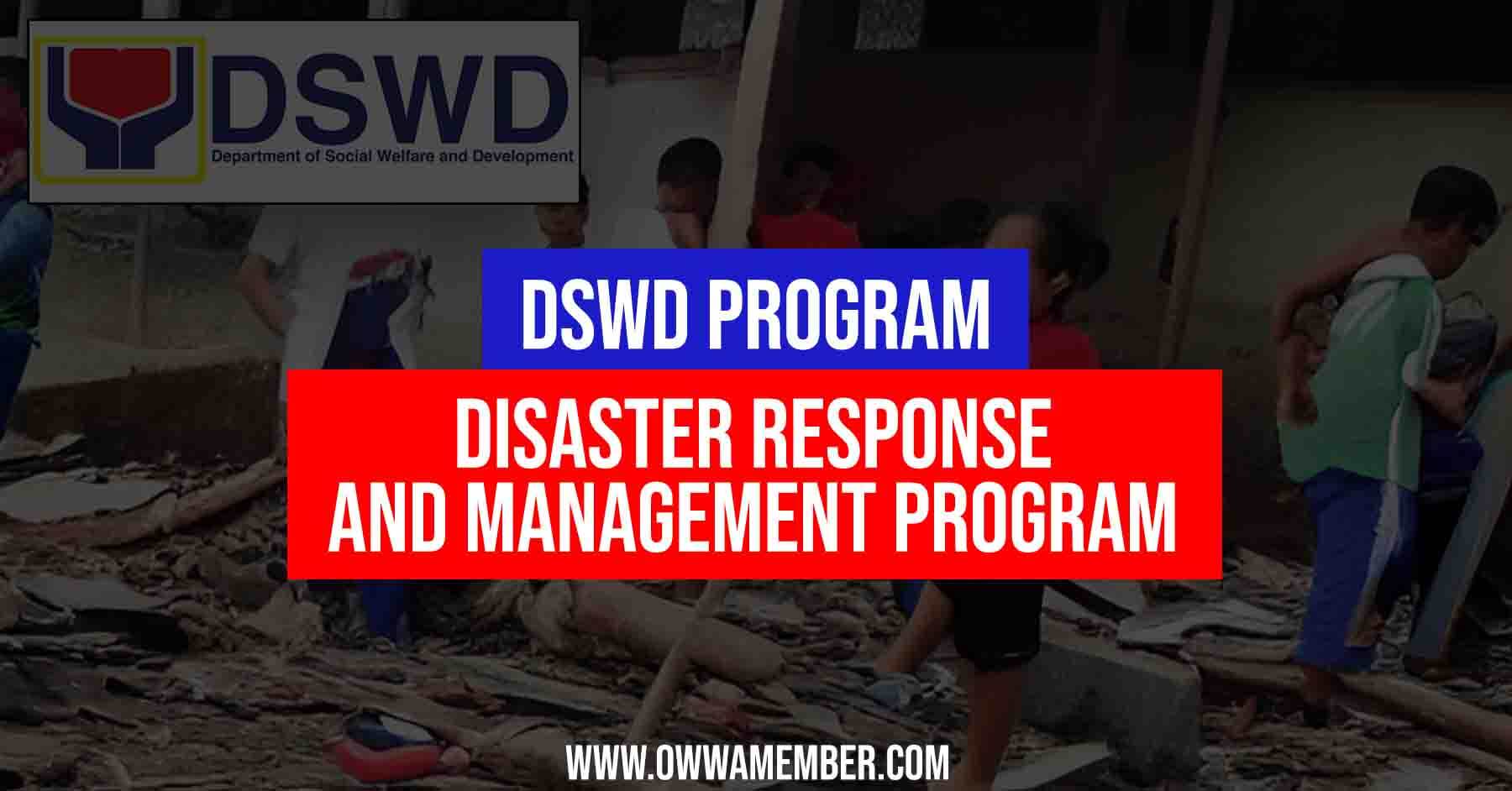
What Is Disaster Response And Management Program?
The program is guided by the National Disaster Risk Reduction and Management Council (NDRRMC), which was formulated in accordance with the Philippine Disaster Risk Reduction and Management Act of 2010. The NDRRMC sets the strategic directions, goals, and objectives of the country’s disaster risk reduction and management efforts.
DSWD’s Response Cluster provides immediate relief assistance in the form of food, water, shelter materials (like tarpaulins and tents), family Kits (containing clothes, and hygienic materials), medical assistance, and psycho-social support, among others.
On the other hand, the Recovery Cluster facilitates livelihood programs, short-term employment, land ownership dispute resolution, and finance for housing construction or repair.
The last one is Rehabilitation which covers interventions for long-term recovery including social services (psychosocial support, education assistance), infrastructure development (potable water supply, electricity, roads), and production support (seeds, tools), among others.
The department’s disaster response and management program are anchored on the following pillars:
Emergency Shelter Assistance (ESA)
One of the forms of assistance provided by the DSWD is emergency shelter assistance (ESA). ESA is provided to families or individuals who have been displaced from their homes due to a disaster. The DSWD ensures that these families or individuals have a place to stay while they wait for their homes to be repaired or rebuilt.
The DSWD provides two types of ESA: temporary shelter assistance (TSA) and permanent shelter assistance (PSA). TSA is provided to families or individuals who will only be displaced for a short period of time, while PSA is given to those who will be displaced for a long period of time.
Relief Assistance
The DSWD provides immediate assistance to families affected by disasters through its Quick Response Fund. This fund is used to finance the procurement of relief goods such as food packs, water containers, blankets, and clothes. The DSWD also deploys social workers to disaster-affected areas to assess the needs of families and help them access government services.
Cash-For-Work (CFW)
This is a short-term solution that offers families a different source of income while fostering civic engagement through temporary employment in exchange for community service and/or training in disaster mitigation, preparedness, response, and early recovery and rehabilitation.
The prevention and mitigation component focuses on reducing the frequency and severity of disasters through preventive measures such as land use planning, building code enforcement, and disaster risk reduction education campaigns.
This component also includes activities that aim to mitigate the impacts of disasters when they do occur, such as flood control infrastructure projects or evacuation center construction.
The preparedness component ensures that communities are ready to effectively respond to disasters when they do occur. This includes creating emergency plans, conducting drills and exercises, stockpiling supplies, establishing early warning systems, and training first responders.
The response component focuses on providing immediate assistance to communities affected by disasters. This includes Search and Rescue (SAR) operations, distributing relief goods, setting up evacuation centers, providing medical assistance, and conducting damage assessment and needs analysis.
The recovery and rehabilitation component helps communities rebuild after a disaster. This includes repairing damaged infrastructure, rehabilitating livelihoods, relocating families to safer areas, providing psychosocial support services, and conducting post-disaster needs assessments.
Rehabilitation
The DSWD assists families in rebuilding their homes and livelihoods through its rehabilitation programs. The department provides financial assistance for damaged houses and livelihood grants for those who lost their source of income due to the disaster.
Risk Reduction
The DSWD implements programs that aim to reduce the vulnerability of communities to disasters. These programs include capacity-building pieces of training on disaster preparedness and risk reduction measures. The department also assists local governments in developing disaster-resilient infrastructures such as flood control systems and evacuation centers.
Reconstruction
For communities that have been totally destroyed by a disaster, the DSWD provides assistance for reconstruction efforts. This includes financial assistance for construction materials and labor costs, as well as technical assistance from engineers and architects.
Who Are Eligible For DSWD Disaster Response And Management Program
The Department of Social Welfare and Development’s (DSWD) Disaster Response and Management Program is open to all Filipinos who have been affected by a disaster. This includes those who have been displaced from their homes, have lost their livelihoods, or have suffered injuries or damage to their property.
The program provides financial assistance to help cover the costs of basic needs such as food, shelter, and clothing. It also offers psycho-social support to help individuals and families cope with the emotional trauma of a disaster. The program is available to both individuals and families and is administered through a network of local social welfare and development offices.
What Are The Benefits Of The DSWD Disaster Response And Management Program
The DSWD Disaster Response and Management Program provides a number of benefits to those who are affected by disasters.
First, it provides relief assistance in the form of food, water, and other basic necessities. This can help people affected by disasters to survive in the immediate aftermath of a disaster.
Second, the program provides temporary shelter and clothing. This can help people affected by disasters to have a place to stay while they wait for their homes to be repaired or rebuilt.
Third, the program provides medical and psychological support. This can help people affected by disasters cope with the stress and trauma of what they have experienced.
Finally, the program helps families and individuals affected by disasters rebuild their homes and livelihoods. This can help people affected by disasters get back on their feet after a disaster has occurred.
Video: DSWD’s Bohol Earthquake Disaster Response & Rehabilitation Efforts
This video is all about the Department of Social Welfare and Development’s (DSWD) efforts to provide relief and rehabilitation assistance to those affected by the Bohol earthquake. The video showcases the various relief operations that have been conducted, as well as the rehabilitation efforts that are currently underway.
Frequently Asked Questions
1. What Are The Social Services Provided By Dswd?
- Supplementary Feeding Program.
- Sustainable Livelihood Program.
- Pantawid Pamilyang Pilipino Program.
- Social Pension Program for Indigent Senior Citizens.
- Domestic Adoption.
- Alternative Family Care Program.
- Recovery and Reintegration Program of Trafficked Persons.
- Minors Travelling Abroad.
2. What Are The 3 Core Social Protection Programs Of Dswd?
The Department of Social Welfare and Development (DSWD) is the Philippines’ nodal agency for social protection. Among its many functions, the DSWD is tasked with providing “assistance and protection to vulnerable and disadvantaged groups and individuals towards the enhancement of their social well-being.”
In line with this mandate, the DSWD implements three (3) core social protection programs, which are:
- The Pantawid Pamilyang Pilipino Program (4Ps)
- The Conditional Cash Transfer (CCT) Program
- The Social Pension for Indigent Senior Citizens Program (SP)
3. How Does DSWD Help The Community?
The Department of Social Welfare and Development (DSWD) provides a wide range of services that are designed to help the most vulnerable members of society. These services include financial assistance, counseling, and skills training.
The DSWD also works with other government agencies and civil society organizations to provide comprehensive support to those in need.
One of the most important ways that the DSWD helps the community is by providing emergency relief in times of disaster. The agency coordinates with local governments and other stakeholders to ensure that relief efforts are well-organized and effective. In this way, the DSWD plays a vital role in supporting the community during times of crisis.
4. What is the DSWD’s role in disaster relief?
The DSWD is a key agency in disaster relief efforts. It coordinates with local governments and other stakeholders to ensure that relief operations are well-organized and effective. In this way, the DSWD plays a vital role in supporting the community during times of crisis.
5. What types of services does the DSWD offer?
The DSWD offers a wide range of services that are designed to help the most vulnerable members of society. These services include financial assistance, counseling, and skills training.
6. How can I get help from the DSWD?
You can get help from the DSWD by contacting your local office. You can also visit the agency’s website for more information. If you are in need of immediate assistance, you can call the DSWD’s 24/7 hotline at 1-800-1125.
Summary
The Department of Social Welfare and Development is on the front when it comes to responding to disasters in the Philippines. From providing relief goods and assistance to organizing evacuation centers and rehabilitation programs, DSWD is committed to helping those affected by natural and human-caused calamities.
With proper planning and preparation, we can reduce the number of lives lost and the damage caused by disasters. By supporting the DSWD’s Disaster Response and Management Program, we can help make our communities safe havens for everyone


